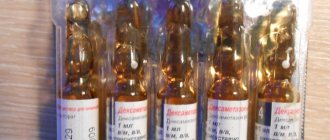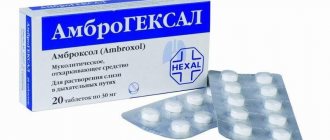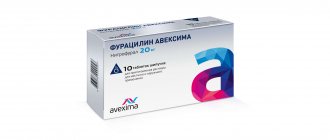Let's discuss Meldonium solution - who should take it, the correct method of administration, dosage in all cases, contraindications, packaging, reviews. Important features from the instructions for use:
How to dissolve vascular plaques, normalize blood circulation, blood pressure and forget the way to the pharmacy
- Sold only with a doctor's prescription
- During pregnancy: contraindicated
- When breastfeeding: contraindicated
- In childhood: contraindicated
- For liver dysfunction: with caution
- If renal function is impaired: with caution
Release form and composition
- injection solution: transparent colorless liquid (5 ml each in colorless glass ampoules with a dot and a notch/break ring, or without a dot and a notch/break ring, 5 or 10 ampoules in a strip pack/cardboard tray with cells, in a cardboard pack of 1 or 2 contour packages/cardboard trays; ampoules that have a break ring or a dot and a notch are supplied with an ampoule knife/scarifier);
- capsules: hard gelatin, 250 mg – size No. 1, with a white body and cap, 500 mg – size No. 00, with a white body and a yellow cap; contents – white hygroscopic crystalline powder with a specific odor (10 pieces in blister packs, 3 or 6 packs in a cardboard pack).
Each pack also contains instructions for using Meldonium.
Composition of 1 ml solution:
- active substance: meldonium dihydrate – 100 mg;
- auxiliary component: water for injection – up to 1 ml.
Composition of 1 capsule:
- active substance: meldonium dihydrate – 250 or 500 mg;
- auxiliary components: calcium stearate, colloidal silicon dioxide (Aerosil), potato starch;
- composition of the shell of capsules of 250 mg: body and cap - gelatin and titanium dioxide;
- composition of the shell of capsules of 500 mg: body - gelatin and titanium dioxide; cap - gelatin, titanium dioxide, sunset yellow and quinoline yellow dyes.
Pharmacological properties
Pharmacodynamics
The active component of the drug, meldonium dihydrate, is a structural analogue of gamma-butyrobetaine. The substance prevents the accumulation of activated forms of unoxidized fatty acids (derivatives of acylcarnitine and acyl coenzyme A) in cells, reduces the transport of long-chain fatty acids through cell membranes, reduces the synthesis of carnitine, and inhibits gamma-butyrobetaine hydroxinase. Due to a decrease in the concentration of carnitine, increased synthesis of gamma-butyrobetaine occurs, a substance that has vasodilating properties.
Under conditions of ischemia, Meldonium restores the balance in the processes of oxygen delivery to cells and its consumption, and also prevents disruption of the transport of angiotensin-converting enzyme (ATP). In addition, the drug activates the process of glycolysis, which occurs without additional oxygen consumption.
Due to the described mechanism of action, Meldonium has the following pharmacological effects: increases performance, reduces manifestations of physical and mental stress, activates tissue and humoral immunity, and has cardioprotective properties.
In case of acute ischemic damage to the myocardium, the drug inhibits the formation of a necrotic zone and shortens the duration of the rehabilitation period. In case of ischemic disorders of cerebral circulation (both acute and chronic), it promotes the redistribution of blood in favor of the ischemic area and improves blood circulation in the ischemic area. In heart failure, it increases myocardial contractility, reduces the frequency of angina attacks, and increases exercise tolerance.
The effectiveness of Meldonium in the case of dystrophic and vascular pathology of the fundus has been confirmed.
The drug has a tonic effect on the central nervous system. Eliminates functional disorders of the autonomic and somatic nervous system during the period of abstinence in patients with alcoholism.
Pharmacokinetics
When administered intravenously, meldonium is characterized by absolute bioavailability - 100%. The maximum concentration (Cmax) in blood plasma is achieved immediately after injection.
When taken orally, the bioavailability of meldonium is 78%. Cmax in plasma is observed 1–2 hours after taking the capsule.
The drug is metabolized to form two main metabolites, which are excreted by the kidneys. Depending on the dose administered, the half-life (T1/2) can range from 3 to 6 hours.
Speaking of meldonium: do mildronate have any side effects?
In April 2020, the World Anti-Doping Association WADA began distributing “amnesties” to athletes whose doping samples were found to contain traces of meldonium, the active substance of the drug Mildronate. Let us remind you that from January 1, it was banned by WADA for use by athletes and declared doping.
In this regard, it is necessary to clarify why the World Anti-Doping Association began to lose its position regarding the drug ban and what role it plays in professional sports. To do this, you need to understand the history of the creation of the drug and clarify what side effects Mildronate has.
The substance, later named meldonium, was developed by a group of Latvian scientists led by Professor Ivars Kalvins at the Latvian Institute of Organic Synthesis in the 1970s.
Initially, it was planned that meldonium would become a derivative of recycled fuel for military and civilian use, but later its creators considered other useful qualities of meldonium. Among these were stimulation of growth of animals and plants. Subsequently, it began to be used to restore strength after heavy physical exertion among the allies of the USSR during the military conflict in Afghanistan.
Today, about 2 million people in the world use it, involved in professional or amateur sports. The medicine is one of the best-selling drugs on the planet, and the scandal that has erupted plays into the hands of its manufacturer’s competitors, who simply have no analogues of Mildronate, which has virtually no side effects. It is used not as a doping, but as a medicine that restores strength after excessive physical exertion.
The quality of production of the substance itself can be judged by the stringent requirements imposed by the EU on the pharmaceutical industry. When Latvia joined the European Union in 2004, one of the mandatory requirements of the European Union regulatory authorities for medicines produced in the country was the presence of a Pharmacovigilance system, which is responsible for monitoring and assessing the consequences of the use of any medicines.
Thus, since the start of research in March 2006, the drug manufacturer has received 478 reports of the use of products that contained meldonium. In none of these cases were there any potential health risks or other side effects of Mildronate. In addition, there have been no reports of the development of dependence or addiction to it after starting to use the drug.
However, the manufacturer indicates in the instructions for the drug as side effects of meldonium that its use can cause dyspepsia, agitation, tachycardia, arterial hypotension and skin itching. People with liver and kidney diseases are also advised to take the drug with caution, because another side effect of meldonium with repeated use is the accumulation of the drug in the body.
For this reason, many athletes who regularly took meldonium before WADA banned it had traces of the drug found in their doping tests. That is, professional athletes, having received appropriate notifications from the anti-doping association, stopped taking Mildronate, but meldonium continued to remain in their bodies for some time. It is in this regard that WADA made exceptions for dozens of sports participants who had positive samples of meldonium residues in their blood.
Among the other contraindications to taking drugs containing meldonium, its manufacturer names pregnancy and breastfeeding, which is more a precaution than any identified negative consequences of using this substance. Thus, it was not clear whether meldonium was excreted in mother's milk, through which it could reach the baby during feeding.
You also need to understand that Mildronate is sold in pharmacies with a prescription from a doctor, who can prescribe this medicine only after checking whether his patient has any contraindications or side effects in relation to meldonium.
In quite rare cases, these include various allergic reactions - redness and rashes on the skin, itching and swelling. Considering that such side effects of meldonium are prescribed in the instructions for most medications in the world, criticism of Mildronate by some biased media is not entirely appropriate.
In addition, many critical articles regarding the drug banned by WADA contain a significant number of errors in the names of both the drug itself and its active substance. Instead of meldonium, journalists often write mildonium or meldonium, and instead of “Mildronat”, “sharks of the pen” mistakenly designate it as “Mildront”, “Mildranat”, “Meldranat” and “Meldranat”.
It is possible that frequently made mistakes may be a consequence of the custom-made nature of the articles: written “in haste”, based on materials downloaded on the Internet, from the first article that came across about Mildronate and its side effects. In addition, such identical inaccuracies may come from the same source of recommendations for writing negative materials about meldonium and Mildronate.
According to doctors who recommend the drug to athletes with health problems, the main achievement of the drug is the successful recovery of the body after long and heavy physical exertion. This is due to the property of meldonium to effectively combat the lack of oxygen during cell ischemia and, in addition, protect against the destructive effects of substances that are formed from certain fatty acids during ischemia.
The only fact regarding Mildronate that has not yet been clarified is WADA’s refusal to say how these therapeutic effects of meldonium relate to doping. Despite the obvious discrepancy, the World Doping Association not only does not provide arguments on this matter, but, as its leader recently stated, intends to increase the secrecy of the organization.
Rate Speaking about meldonium: do mildronate have any side effects at all?!
Overall rating: 3 out of 5 86 52
34
Overall impression: (15)
Efficiency: (12)
Side Effect Strength: (24)
Fairness of price: (14)
Indications for use
For solution and capsules:
- coronary heart disease (angina pectoris, myocardial infarction), chronic heart failure, cardiomyopathy against the background of dyshormonal manifestations - as part of complex therapy;
- acute and chronic cerebrovascular accidents (cerebrovascular insufficiency, stroke) – as part of complex therapy;
- withdrawal syndrome in chronic alcoholism - in addition to specific therapy for chronic alcoholism;
- decreased performance, mental and physical stress (including among athletes).
Additionally for the solution - as part of complex therapy:
- hemophthalmos and retinal hemorrhage of various etiologies;
- retinopathy of various etiologies (including diabetic and hypertensive);
- thrombosis of the central retinal vein and its branches.
Additionally for capsules: postoperative period (in order to speed up rehabilitation processes).
The use of meldonium in sports
Meldonium helps the athlete's body cope with high loads
Athletes, both professionals and amateurs, show particular interest in Meldonium. Exhaustive training exhausts the body, and at a certain point it cannot cope with severe overexertion.
Meldonium-based drugs can help the body cope with such a load.
Action of Meldonium for sports purposes:
- helps expand the body's capabilities, increase and improve performance by increasing overall performance
- helps to increase the effectiveness of training, increase its duration and load by dulling the body's reaction to physical and mental fatigue
- gives endurance to achieve the desired results, the athlete becomes stronger and more agile
- helps to quickly restore strength after training due to the fact that the processes of removing breakdown products from cells and recovery are accelerated
The drug can be used for any type of load. But by itself it does not affect muscle gain. He can only give strength to gain it.
Meldonium helps athletes engaged in long-term anaerobic training. These include athletes, football players, skiers, etc. The drug protects the heart from overload and avoids serious pathologies.
Meldonium is also used for weight loss. By accelerating metabolism in cells, calories are burned faster. The process of losing weight goes faster.
Meldonium relatively recently began to be used in sports. Initially, it was considered a vitamin supplement that had no effect on athletic performance. But after the doping scandal, attitudes towards the drug changed greatly. Now it is classified as a hormonal modulator. Athletes are prohibited from taking Meldonium both during training and competition.
Meldonium, instructions for use: method and dosage
Injection
Meldonium injections are administered intramuscularly (IM), intravenously (IV) or parabulbar.
Administration of the drug is recommended in the first half of the day, due to the possible development of an stimulating effect.
The method of administration, dose of Meldonium and duration of its use are determined by the doctor individually, taking into account the indications and severity of the condition.
Complex therapy of cardiovascular diseases:
- myocardial infarction: iv bolus 500–1000 mg per day in one or two injections;
- stable angina in coronary heart disease, chronic heart failure and cardiomyopathy caused by hormonal disorders: iv bolus 500–1000 mg per day in one or two doses for 10–14 days, then the patient is transferred to the oral form of the drug. The general course of treatment is 4–6 weeks.
Complex therapy of cerebrovascular disorders:
- acute phase: 500 mg IV 1 time per day for 10 days with further transfer of the patient to the oral form of the drug. The general course of treatment is 4–6 weeks;
- chronic form of the disease: 500 mg IV 1 time per day for 10 days, followed by transfer of the patient to the oral form of the drug. The general course of treatment is 4–6 weeks; on the recommendation of a doctor, repeated courses are carried out 2–3 times a year.
Other indications:
- ophthalmological disorders: parabulbar 50 mg for 10 days;
- chronic alcoholism: IV or IM 500 mg 2 times a day for 7–10 days;
- mental and physical overload: 500 mg IV or IM once a day for 10–14 days. If necessary, a repeat course is given after 2–3 weeks.
Capsules
In capsule form, Meldonium should be taken orally before meals.
Recommended dosage regimens:
- disorders of blood supply to the brain: 500–1000 mg per day (preferably in the morning) for 4–6 weeks;
- chronic heart failure, stable angina (as part of complex therapy): 500–1000 mg per day in one or two doses for a course of 4–6 weeks;
- cardialgia caused by dyshormonal myocardial dystrophy: 250 mg 2 times a day for 12 days;
- alcohol withdrawal syndrome: 500 mg 4 times a day for 7–10 days;
- decreased performance, mental and physical overload, acceleration of rehabilitation in the postoperative period: 250 mg 4 times a day for 10–14 days, if necessary, treatment is repeated after 2–3 weeks;
- physical overload in athletes: 500–1000 mg 2 times a day before training for a course of 14–21 days during the preparation period, 10–14 days during the competition period.
Reviews
Patients note that the medication shows good results already in the first days of use. The bioavailability of the drug is quite high. Therefore, from the very beginning the patient feels a surge of strength and energy. If you take drugs from this group correctly, adverse reactions develop quite rarely. It is no coincidence that Meldonium is so popular today.
The price of the medicine is another advantage. For one package of medicine you will have to pay no more than 180 rubles. The drug is available without a prescription, and can be found in almost any pharmacy. As a last resort, a specialist will recommend a high-quality analogue.
Side effects
Meldonium is generally well tolerated; in rare cases (<1/1000), the following side effects occur:
- from the gastrointestinal tract: dyspeptic disorders;
- from the nervous system: psychomotor agitation;
- from the cardiovascular system: decrease or increase in blood pressure, tachycardia;
- from the immune system: allergic reactions: skin rash, redness of the skin, itching, angioedema, eosinophilia;
- general disorders: general weakness.
special instructions
Meldonium is not a first-line drug for the treatment of acute coronary syndrome, so its use is not strictly necessary.
Meldonium dihydrate can give a positive result during doping control, therefore, since January 1, 2016, it has been included in the list of prohibited substances of the World Anti-Doping Agency.
Impact on the ability to drive vehicles and complex mechanisms
There is no data indicating a negative effect of meldonium on a person’s psychophysical and cognitive abilities.
How does Mildronate interact with other drugs?
Mildronate can interact with other medications and inhibit their effectiveness, or, on the contrary, improve it. Therefore, treatment with this medicine can only be carried out after consultation with a doctor and under his supervision.
- It is forbidden to use this remedy with other medications that contain meldonium, since in this case there is a possibility of side effects.
- People who suffer from kidney and liver disorders should use this medication extremely carefully and only under the supervision of a doctor.
- Since there is no data on the safety of taking Mildronate during pregnancy and breastfeeding, the medicine cannot be used during these periods.
- There is no data on the effect of the drug on human reactions.
What can you combine with?
Drug interactions
The simultaneous use of diuretics, antiplatelet agents, anticoagulants, bronchodilators, antiarrhythmic and antianginal drugs is allowed.
Caution should be exercised when combined use of peripheral vasodilators and antihypertensive drugs (including nifedipine, alpha-blockers) is necessary, since such a combination can cause the development of moderate tachycardia and arterial hypotension.
Meldonium enhances the effect of coronary dilatants, cardiac glycosides and some antihypertensive drugs.







